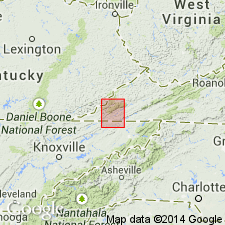
- Usage in publication:
-
- Moccasin limestone*
- Modifications:
-
- Original reference
- Dominant lithology:
-
- Limestone
- AAPG geologic province:
-
- Appalachian basin
Summary:
Pg. 2. Moccasin limestone. Red argillaceous limestone, passing into blue flaggy Chickamauga limestone and into blue and yellow Sevier shale above, beting intermediate between the deep-sea deposits of northwestern part of quadrangle and arenaceous shore deposits of Bays syncline. Maximum thickness 500 feet. [Age is Middle Ordovician (Lowville).]
Source: US geologic names lexicon (USGS Bull. 896, p. 1392).

- Usage in publication:
-
- Moccasin limestone member*
- Modifications:
-
- Revised
- AAPG geologic province:
-
- Appalachian basin
Summary:
The rank of the Moccasin is reduced to the Moccasin limestone member of the Lowville limestone. Unit consists of reddish argillaceous limestone, 50 feet thick, that makes up the upper part of the Lowville in Wise and Scott Cos., VA. The Moccasin overlies the fine-grained, drab limestone of the Lowville. The age of the Moccasin limestone member is Middle Ordovician.
Source: GNU records (USGS DDS-6; Reston GNULEX).
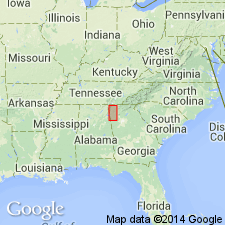
- Usage in publication:
-
- Moccasin limestone, facies
- Modifications:
-
- Areal extent
- AAPG geologic province:
-
- Appalachian basin
Summary:
Geographically extended the Moccasin limestone to GA. The Moccasin is included with the Lowville as facies of the same general formation with the Lowville facies being bluish or dove-colored limestone and the Moccasin being predominantly red. Thickness of the combined unit it 250 to 1000 feet. The Lowville-Moccasin unit overlies the Lebanon limestone, but where the Newala limestone and Stones River group are absent, the unit rests on Knox dolomite.
Source: GNU records (USGS DDS-6; Reston GNULEX).
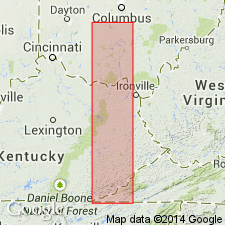
- Usage in publication:
-
- Moccasin limestone
- Modifications:
-
- Areal extent
- AAPG geologic province:
-
- Appalachian basin
Summary:
Geographically extended the Moccasin limestone to the subsurface of OH. Unit is 128 feet thick. It conformably overlies the Lowville limestone and conformably underlies the Eggleston limestone. The Moccasin is of Middle Ordovician age.
Source: GNU records (USGS DDS-6; Reston GNULEX).
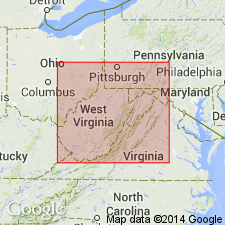
- Usage in publication:
-
- Moccasin Formation
- Modifications:
-
- Revised
- AAPG geologic province:
-
- Appalachian basin
Summary:
Revised the Moccasin Formation as a unit within the Trenton Group in WV. Unit occurs in Mercer and Monroe Cos.
Source: GNU records (USGS DDS-6; Reston GNULEX).
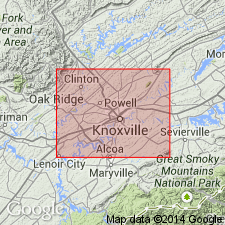
- Usage in publication:
-
- Moccasin Formation
- Modifications:
-
- Revised
- AAPG geologic province:
-
- Appalachian basin
Summary:
Revised the Moccasin Formation to a formation within the Chickamauga Group in TN. Consists of calcareous, grayish-red, and greenish-gray mudstone with shrinkage cracks and mudcracks, and gray, fossiliferous limestone. Two thin metabentonite beds occur in the upper part. Unit is 950 feet thick. It conformably overlies the Ottosee Shale and underlies the Bays Formation. The Moccasin is more calcareous than the Bays. The age of the Moccasin Formation is Middle Ordovician.
Source: GNU records (USGS DDS-6; Reston GNULEX).
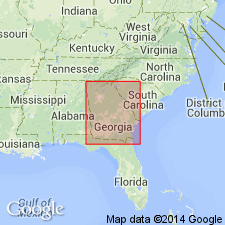
- Usage in publication:
-
- Moccasin Limestone
- Modifications:
-
- Revised
- AAPG geologic province:
-
- Appalachian basin
Summary:
Revised the Moccasin Limestone as a formation within the Chickamauga Group in GA. Unit overlies the Ridley Limestone and underlies the Bays Formation.
Source: GNU records (USGS DDS-6; Reston GNULEX).

- Usage in publication:
-
- Moccasin Formation
- Modifications:
-
- Age modified
- AAPG geologic province:
-
- Appalachian basin
Summary:
The Moccasin Formation in west central VA is modified to be of Late Ordovician age. It overlies the McGlone Formation and underlies the Eggleston Formation, both of Late Ordovician age, and is equivalent to the Edinburg Formation and Nealmont Limestone. The Moccasin consists of limestone, mudstone, and argillaceous limestone that is interpreted to be deposited in a tidal flat environment.
Source: GNU records (USGS DDS-6; Reston GNULEX).

- Usage in publication:
-
- Moccasin Formation
- Modifications:
-
- Overview
- AAPG geologic province:
-
- Appalachian basin
Summary:
The Moccasin Formation can be divided into 3 units, a lower, middle, and upper. The lower unit consists of more than 100 feet of red claystone and impure limestone. The middle unit is less than 100 feet thick and is a fossiliferous, gray calcilutite with some grayish-yellow, shaly limestone; the upper part of this unit contains black chert nodules. The upper unit is 300 feet of red, yellow, and green claystone and shale, with some fine-grained limestone. The Moccasin overlies the Witten Limestone and underlies the Martinsburg Shale. Age of the Moccasin Limestone is Middle Ordovician.
Source: GNU records (USGS DDS-6; Reston GNULEX).
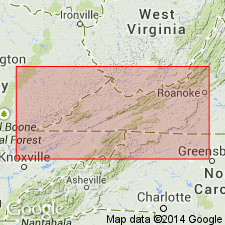
- Usage in publication:
-
- Moccasin Formation
- Modifications:
-
- Overview
- AAPG geologic province:
-
- Appalachian basin
Summary:
Three Rocklandian K-bentonite beds occur in the Valley and Ridge province of southwest VA, southeast WV, and northeast TN. The older two are identified as the Deicke and Millbrig K-bentonite Beds, mapped previously in the Upper Mississippi Valley. The Deicke (oldest of the three beds) is equivalent to K-bentonite V-3 in the central Valley and Ridge and occurs in or just above the redbeds of the Moccasin Formation (Walker Mountain Sandstone [Member]) in the New River Valley. At Hagan, and several other places in southwestern VA, the Deicke and Millbrig occur in the Eggleston Formation. Using the bentonites as time lines, it has been determined that the bases of the Eggleston, Bays, and Trenton ("Martinsburg") Formations become younger to the northeast. The Walker Mountain Sandstone Member of the Moccasin and Bays Formations also becomes younger to the northeast. Correlation charts. Cross sections. Measured sections in Appendix.
Source: GNU records (USGS DDS-6; Reston GNULEX).

- Usage in publication:
-
- Moccasin Limestone*
- Modifications:
-
- Overview
- AAPG geologic province:
-
- Appalachian basin
Summary:
Moccasin Limestone. According to Ross and others (1982), Ottosee Shale, Moccasin Limestone, and Eggleston Formation of eastern Tennessee correlate with Tyrone Limestone of north-central Tennessee.
Source: Modified from GNU records (USGS DDS-6; Reston GNULEX).

- Usage in publication:
-
- Moccasin Formation*
- Modifications:
-
- Overview
- AAPG geologic province:
-
- Appalachian basin
Summary:
The Moccasin Formation occurs in the subsurface of VA and WV in the area between the St. Clair and Pulaski thrust faults as shown in section F-F'. Overlies the Witten Limestone and underlies and interfingers with the Eggleston Formation. The Moccasin is of Middle Ordovician (Rocklandian) age.
Source: GNU records (USGS DDS-6; Reston GNULEX).
For more information, please contact Nancy Stamm, Geologic Names Committee Secretary.
Asterisk (*) indicates published by U.S. Geological Survey authors.
"No current usage" (†) implies that a name has been abandoned or has fallen into disuse. Former usage and, if known, replacement name given in parentheses ( ).
Slash (/) indicates name conflicts with nomenclatural guidelines (CSN, 1933; ACSN, 1961, 1970; NACSN, 1983, 2005, 2021). May be explained within brackets ([ ]).

